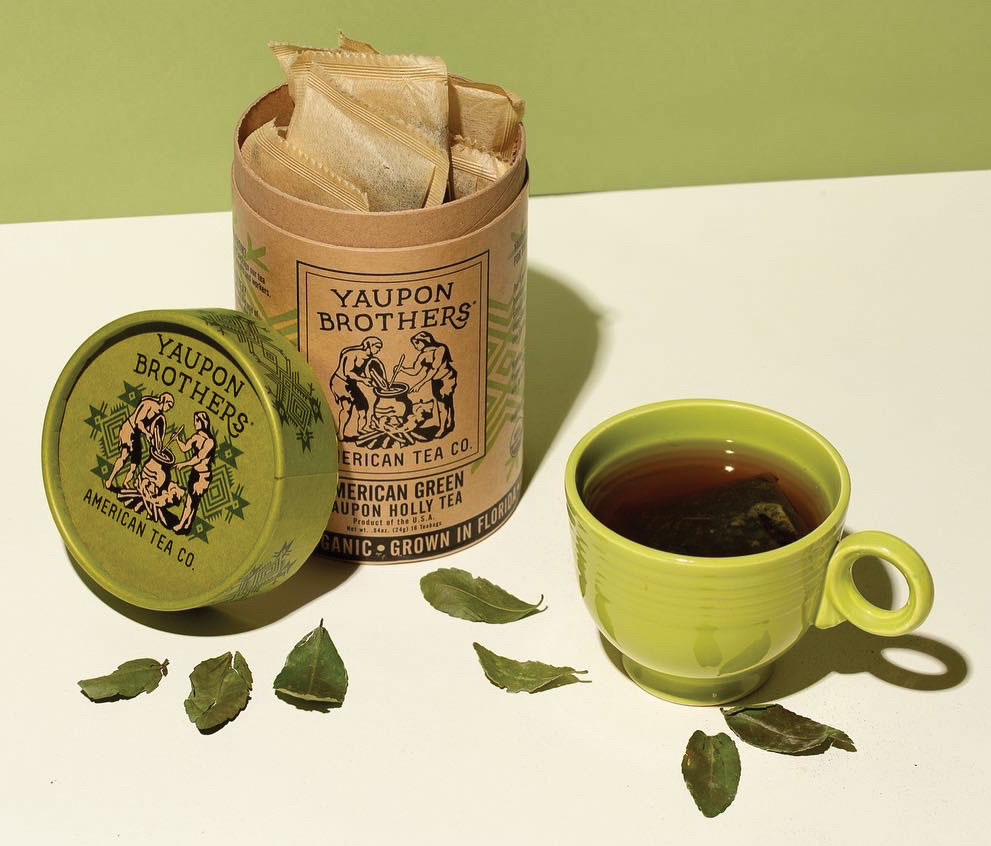 For generations further back than she can trace, Laura Cummings Balgari’s ancestors had a close relationship with yaupon holly. As Indigenous people of the Pee Dee and Natchez Nations, they foraged and cultivated the shrub in the coastal regions of the Southeast. But Balgari, who codirects the Atlanta Indigenous Peoples Association, has had to piece together her personal connection like a puzzle.
For generations further back than she can trace, Laura Cummings Balgari’s ancestors had a close relationship with yaupon holly. As Indigenous people of the Pee Dee and Natchez Nations, they foraged and cultivated the shrub in the coastal regions of the Southeast. But Balgari, who codirects the Atlanta Indigenous Peoples Association, has had to piece together her personal connection like a puzzle.
Yaupon is North America’s only native caffeinated plant. Its leaves were steeped like tea and drunk as an important part of Indigenous social and ceremonial life across the continent for thousands of years, until colonial laws prohibited tribal practices. Colonists drank yaupon casually when British taxes made tea inaccessible to them in the late 18th century, and enslaved Black people in certain parts of the South grew the shrub for personal consumption. It ultimately fell out of favor—perhaps due to its misleading botanical name, Ilex vomitoria. (Yaupon itself is not an emetic, but it may have been used in cleansing rituals where it was consumed in such volume as to induce vomiting.)
Yet in the last 10 years, the plant has experienced a resurgence, with a cohort of growers throughout the South producing yaupon tea on a commercial scale. It’s now available from national retailers like Walmart and regional coffee shop chains like Foxtail Coffee. Whole Foods named it one of the top 10 food trends of 2023.
Most people who consume yaupon today, though, are not Indigenous and aren’t thinking of it as a sacred plant. They think of it as a product—a warm (or iced) cup to get them going in the morning. They enjoy it as a caffeinated alternative to coffee, providing a boost of energy and alertness without the jitters. (It has about a third as much caffeine.) Devoid of tannins, it has a smooth mouthfeel, and it tastes almost like a Chinese green tea, but undeniably sweeter. Even more perks: It can be resteeped again and again, and has beneficial antioxidants.
As interest rises, consumers and scholars have become curious about yaupon’s history, which has led to long-lost historical records resurfacing. Since so much Indigenous knowledge of the plant was lost, Balgari uses those records and connects online with people who share her heritage to learn more about her personal ties to yaupon. It’s part of the decolonization process, she says.
“How do we bring yaupon back into our lives, and [other] plants that our ancestors had a relationship with?” Balgari says. “We’ve all felt that it’s missing.”
• • •
Atlanta-based investor Morgana Freeman likes to spend her time off seeing the world with a group of friends. Freeman, who describes tea as “a way of life,” has noticed that no matter where she travels, it seems like most of the tea experiences she finds are thematically British. So when she learned about yaupon, part of the appeal for her was its local history, industry, and consumption.
“I love this whole idea about how are Americans engaging with tea?” she says. “This is a whole new narrative. We still have an opportunity to make teatime our own. And I think yaupon is going to do that wonderfully. We’re going to redefine American teatime.” About two years ago, Freeman met Bryon White, CEO of Ilex Organics, the parent company of Yaupon Brothers in Edgewater, Florida. White told Freeman about Ilex Organics’ emphasis on education and equity, and Freeman says the opportunity to invest was a “no-brainer.”

Photograph by Growl
Burgeoning sales of a local tea product could be good for the land, too, which is a huge draw for local farmer and herbalist Tim Hayes. Hayes used to grow and sell yaupon at Hearthfire Farm and Nursery, which he operated in the Atlanta area. He now lives in Henry County, and while his farm project is on hold, he still makes trips southward to forage yaupon in the coastal areas where the sandy, salty soil allows it to grow abundantly.
Coffee and true tea (Camellia sinensis) are produced on other continents, and transporting them to the U.S. comes with a hefty carbon footprint. Years ago Hayes—a self-described “caffeine fiend”—started looking for a coffee alternative with a softer environmental impact, and he found yaupon. “People are trying to be more green and environmentally conscious,” Hayes says. “Having something that’s readily available instead of being from all the way on the other side of the world makes your community more resilient.”
While yaupon has perks for mainstream consumers and for the planet, a major question remains: As sales continue to climb, how can the industry ensure justice for the descendants of the people who cultivated it and spiritually connected with it long ago?
For Crystal Stokes, president of the American Yaupon Association, that’s just as critical to yaupon’s future as commerce. As a Black woman, Stokes says she can empathize with Indigenous erasure because her ancestors had a similar experience: “Black culture is continuously being appropriated,” she says. Native people “continue to experience the same. Both experienced great loss and continue to experience great loss.” In the pursuit of equity and inclusion, the association partners with its members to help them find ways to create job opportunities in some of the country’s poorest areas, such as the Mississippi Delta; educate consumers about yaupon’s history; and sign on more farmers of color. “The tea and beverage industry is completely whitewashed, and that needs to change,” Stokes says.

Photograph courtesy of Yaupon Brothers
So far, few Indigenous people are involved in the commercial yaupon industry—likely due, Stokes says, to trauma associated with cultural erasure, which has been passed down through generations. “Existing in all-white spaces and industries can be hard for Black people and people of color and is not desirable to many of us,” she says.
But in that disparity, Balgari sees an opportunity for healing. She’s still searching for answers about how to bring yaupon back into the lives of Indigenous people, and she says that for her, that might mean researching and learning how her ancestors cultivated yaupon so she can grow it the same way herself. But she’s also interested in sharing Indigenous traditions, like yaupon, with others. “Native people have been in survival mode for a very long time, and I think now we have to move beyond that. I feel like we’re in a time right now where we have to share our knowledge,” Balgari says. “People will be better for it. It benefits everybody to absorb Indigenous values.”
How to harvest, roast, and steep yaupon
If you’re completely confident you’ve identified a wild yaupon shrub and that you have permission to forage from it—or if you’re growing yaupon in your yard—here’s how to turn it into tea, according to local farmer and herbalist Tim Hayes.
1. Grip one of the branches and strip the leaves off in one pull. Collect the leaves in a bag. “I try not to take too many leaves off one plant, maybe 5 percent,” Hayes recommends. If harvesting from a female plant, do not collect the berries.
2. Lay out the leaves on screens or baskets in a clean place with as little humidity as possible to dry them. This might take a few days. When the leaves crunch and crumble apart, they’re ready to roast.
3. Spread the leaves on a cookie sheet and roast in the oven at a low temperature. Hayes sets the oven to 200 degrees then turns it off every few minutes to ensure it stays between 150 and 200 degrees while the leaves are roasting.
4. When the leaves are golden and become aromatic, you can stop roasting. Hayes says it’s like when you’re baking cookies and can suddenly smell them throughout the room. If you continue roasting a little longer, you can achieve a dark-roast tea that will have less caffeine (but don’t let it burn!).
5. Let the leaves cool, then store them in airtight bags or jars.
6. When you’re ready to make a cup of tea, pulse leaves in a coffee grinder—it increases the surface area so you can extract the full flavor.
7. Steep 1 tablespoon pulsed leaves in 8 ounces boiling water for 5 to 10 minutes. Strain; the leaves can be re-steeped for two or three more cups.
This article appears in our June 2023 issue.












